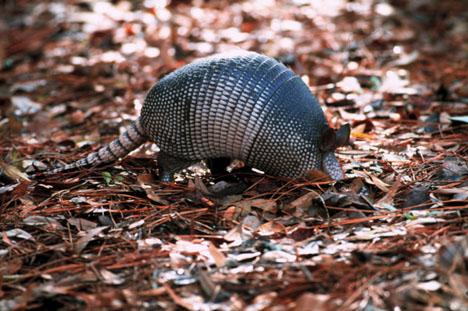Armadillos: now adapting to new habitats in southern Illinois

The Associated Press
Sep 20, 2006
Last updated on May 12, 2016 at 04:38 a.m.
For years, Lloyd Nelson laughed at myth reports that armadillos – those armored, football-sized critters with the big claws and bigger nose – had waddled their way into southern Illinois, the same place folks say they’ve seen cougars.
Folks weren’t fibbing about the mountain lions. Nelson knows now they weren’t joshing about armadillos, either.
Since his run-in with an armadillo that was turning a woman’s flower bed into a crater three years ago, the Jackson County animal-control chief says he’s logged 13 sightings of the stubby-legged kin to sloths and anteaters in this county alone. Most were dead as doornails along roads; the leathery animals with poor vision are no match against highway traffic.
“We’ve had armadillos killed on the road just about every year” since 2003, says Nelson, reflecting what wildlife specialists say is ample evidence that the creatures with the pencil-thin tail are nudging their way northward from their southern U.S. climes.
Get The Daily Illini in your inbox!
“We’ve got them in Nebraska; that’s as far north as we have any records,” said Lynn Robbins, biology professor at Missouri State University. “They’re adapting, filling in so many places.”
To Robbins, the prehistoric-looking armadillo – Spanish for “little armored thing” – is here to stay.
Exactly how many of Texas’ official state mammal have made their way into the Midwest remains elusive. But observers say the remarkable advance may have been aided by the region’s lack of predators and the abundance of favorable habitat such as forests and river valleys.
Milder winters packing less long-standing snow and ice – the bane of armadillos who have little body fat, don’t hibernate and rely on their noses to root out beetles, grubs and earthworms – hasn’t hurt, either, observers say.
“All the evidence, the sightings and the number of road kills would indicate that their numbers are increasing,” said Clay Nielsen, a wildlife ecologist at Southern Illinois University in Carbondale. In Illinois in recent years, “there’s been quite a spurt in sightings” of the nocturnal animal.
Just how they’re getting here also isn’t clear. Some may have been released by people, either as pranks or by folks second-guessing the sensibility of having them as pets. Others suspect the armadillos are master stowaways, freeloading rides north on barges or railroad cars.
Or “maybe they’re coming from Missouri on their own four feet,” perhaps using bridges to conquer the Mississippi River separating that state from Illinois, says Joyce Hofmann, senior research scientist with the Illinois Natural History Survey’s center for wildlife and plant ecology in Champaign. “This is just the direction they’re headed.”
So it goes for the armadillo, which first forayed into the Lone Star State across the Rio Grande from Mexico in the 1800s, eventually spreading across the Southeast. There, they’ve been common road kill – jokingly described by some as “possums in a half shell” – and a burrowing nuisance to homeowners, cemetery caretakers and golf course superintendents.
“They move a lot of dirt,” Robbins says.
While armadillos have been known to carry leprosy, cases of that disease being transmitted to humans is rare, officials say.
“I don’t think many people pick up armadillos,” Hofmann says.
The animals are far more of a health nuisance with their chronic rooting, posing risks to humans, cattle and other wildlife if they step into holes left by the prolific diggers.
Wildlife enthusiasts are using the northward march of the armadillo as an opportunity to educate others about the animals, which during the Great Depression were known as “Hoover Hogs” by down-on-their-luck Americans who had to eat them instead of the “chicken in every pot” Herbert Hoover had promised as president.
A casual search of the Internet shows that folks still eat armadillos, with plenty of recipes available for dishes such as armadillo casserole, armadillo in mustard sauce, and armadillo in cream sauce. Anyone hankering for armadillo meatballs?
None for Nelson, thanks. He got his fill the day he came face-to-face with the one he corralled by the tail in the woman’s flower bed.
“They stink, and they urinate and defecate like any animal does when they’re stressed,” he says. “They’re kind of nasty creatures if you ever get close. They’re interesting and marvelous biologically, but the smell …”





